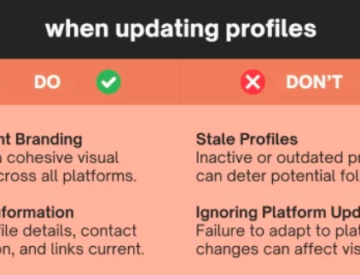I recently ran a series of posts for the French side of this blog, interviewing different tourism organizations in the province of Quebec that execute many aspects of their travel marketing strategy effectively. There was a big city hotel, a destination spa in the Eastern Townships, a regional destination marketing organization (DMO), a cultural promotion office and a well-known resort located North of Montreal. Each have different realities, yet similar approaches and concerns.
However, when I asked them what was their greatest challenge in managing social media moving forward, they gave very different answers. And from my experience in the past four years in this sphere, it’s a safe bet that these concerns are shared by many in the tourism & travel industry.
1. Staying in the know
 The social media landscape evolves so fast that many feel ignorant or fear being left in the cold with all these changes. When it’s not Facebook making its almost-monthly major facelift, it’s Youtube introducing changes to its branded channels, Twitter promoted tweets or LinkedIn changing its company pages.
The social media landscape evolves so fast that many feel ignorant or fear being left in the cold with all these changes. When it’s not Facebook making its almost-monthly major facelift, it’s Youtube introducing changes to its branded channels, Twitter promoted tweets or LinkedIn changing its company pages.
Not to mention when a new-comer like Pinterest shows up, or Google+ taking its foothold or Instagram becoming the new must-have, must-do-something-with application for destinations and hotel marketers alike.
More than 80% of organizations in the tourism industry are small or medium businesses (SMB), with many Mom & Pop shops or solo-preneur inns and family-owned restaurants. Staying abreast of every change in social media and its implication is near impossible, so many rely on their DMO officers for know-how and training in order to stay on top of things.
2. Being consistent
For some, it’s a challenge in itself to find enough content to fill up an editorial calendar and publish accordingly across all the channels managed by the organization. For others, content is not the issue: being consistent is.
While there may be plenty of texts, contests, interviews, photos, and videos to engage in a variety of conversations, the challenge is to resonate with the audience and this requires a more in-depth approach than simply “churn out content”. When you rely on members or partners to provide quality content to your audiences, you also depend on their understanding of the priorities at hand.
And while I did mention the necessity of an editorial calendar in the previous paragraph, this should not be taken as a given. For many organizations, this is still a struggle and many just go with the flow, with the uneven frequency and frustrations this can create.
3. A clear and measurable strategy
 Back in 2008 or 2009 when most tourism organizations started treading the waters of social media, it was almost normal NOT to have a strategy in place for these platforms. It was more trial and error, fail fast, learn and move on.
Back in 2008 or 2009 when most tourism organizations started treading the waters of social media, it was almost normal NOT to have a strategy in place for these platforms. It was more trial and error, fail fast, learn and move on.
While this is a mantra I still believe in, it no longer makes sense for travel organizations to approach social media that way. It’s not acceptable (was it ever?) to do what I call “me-too marketing”, whereby you set up a Facebook page because your next-door competitor did so just last week.
Social media should be approached under the overall business objectives and targets, not just under marketing strategies. What is the hotel, destination, or resort seeking to achieve in 2012: increase brand awareness? drive traffic to the website? reduce calls or visits in the information center? increase numbers of resumes sent to the company for recruiting purposes?
What’s the strategy?
Defining the strategy should identify the target audiences which, in turn, will define which social media are best to achieve goals sought for the organization. For each target, there also needs to be specific and measurable indicators so one can track progress and fine-tune the approach as one moves forward.
Few organizations are at this level, and failure to report appropriately how social media is managed is perhaps one of the biggest challenges tourism organizations are facing right now.
Failure to report appropriately how social media is managed is perhaps one of the biggest challenges tourism organizations are facing right now
4. Demonstrating ROI
Stemming directly from the previous point, the need to demonstrate return on investment is certainly a major point but, surprisingly, did not spring out from the various conversations held with industry stakeholders. Truth be told, save for a chosen few examples, for many tourism organizations in Quebec social media is the part-time job of one individual.
Thus, return on investment is not a major challenge. Yet. But once the need will be identified to add a resource, or simply have a full-time person to manage this reality, the question will arise: what’s the return on that investment?
Social media is often managed under marketing, when there is a marketing department, or by the savvy, tech-inclined coordinator who was hired for other reasons but will end up helping out with “the social media stuff”. Once organizations will truly realize that blogging, engaging on Facebook, Twitter, LinkedIn, Google+ or Pinterest is not just a marketing function but something that permeates across the whole company, including above all customer service, it will be a rude awakening…
5. Integrating social media into business processes
Finally, there are a few organizations that have come to realize that indeed, social media should not be the sole ownership of marketing. When questions asked on the Facebook page relate to shareholders or community relations, it’s a matter of Public Affairs. When conversations on LinkedIn deal with corporate culture, or B2B sales leads, it’s a matter of Human Resources and Sales. Or when irate customer lash out on Twitter or via blog posts, why should it be the “marketing-based social media guy” that answers?
Task forces need to be put in place and, more fundamentally, corporate cultures need to change. Social media impacts every aspect of how organizations work and the need for open leadership is more compelling than ever. In order to properly respond to real-time customer service, real-time marketing and communications, organizations need to adapt accordingly and adopt transparency, openness and empowerment to front line employees in order not only to survive, but to strive in this new reality.









Leave a Reply